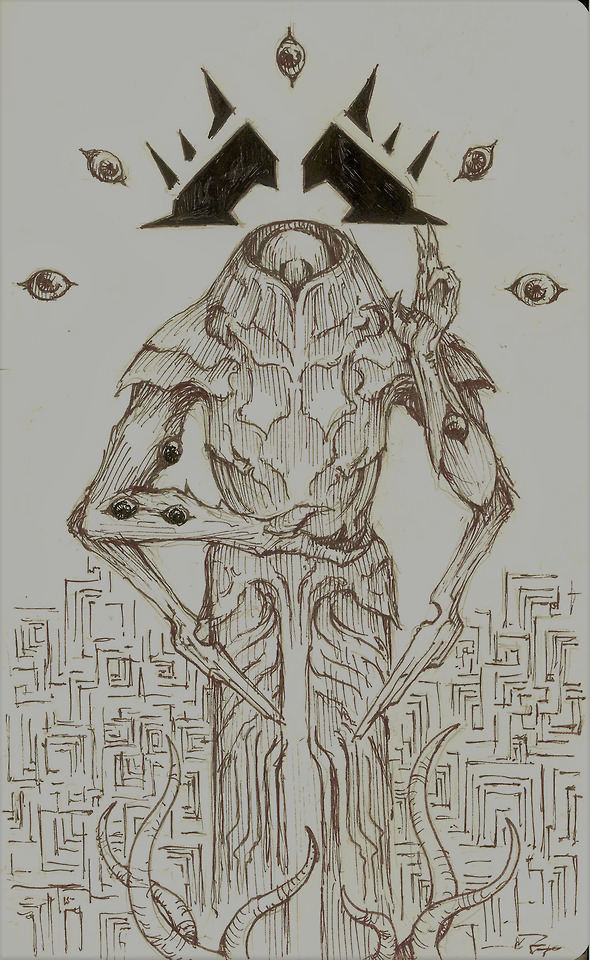Note
Couldn't the Weatherlight be coated in lazotep with the crew inside to allow planar gating like Rashmi's gate allows for the eternals? Or am I missing something about the eternals that makes them technically inorganic?
You would have to coat the crew with lazotep which would kill them. The zombies have the whole “already dead” thing going for them.
77 notes
·
View notes
Text
I would like a cycle of revisiting the past of known planes like in Urza Saga, Mtg Origins or M19
Let say the limitation must be after the mending so we can have Planeswalker cards:
1- Ixalan - A set about how the vampires conquered Tezeron a hundred years ago. For the tropes, use Game of Thrones / the Italians wars of the 15th century. Each nations has it's mix of colors and mechanic like in Khan of Tarkir.
2- Kaladesh during the Great Aether Boom in the moutain ranges of Lathnu and the badlands beyond. Energy are still scarce (only at rare) Tropes; western and gold rush in America. A Vedalken compete against an Aetherborn on who could join these location with their Aether-train. We have a really young Piran Nalaar following is father in the far west. We also get the origin story on how Dovin Baan spark ignited (flip card)
3- Shards of Alara - with origins stories of Tezzeret in the Tidehollow and Ajani in the jungles of Alara. We learn how their spark ignited.
4- Zendikar during the exploration era, like in the first set and no Eldrazi, except the reference with the forgotten gods. We get the origins story of most of the legendaries character native of Zendikar. Maybe a war on one of the continent with the 5 different tribes and their own mechanics like in Tarkir (Kor - Vampire - Goblins - Merfolks - Elfs)
5- Amonkhet - This one after Hour of Devastation. The wandering tribes in the desert explore ruins from the old civilisations before the coming of the God Pharaoh.
#mtg
Inquiring Minds Want To Know - Planes to Visit in the Future
In today’s information gathering, I’m interested to hear what planes you want to visit in an upcoming Standard-legal set. Here’s how I would like you to respond. Please list, in order, your favorites from one up to five. You can list less than five, but please restrict yourself to five answers. Number 1 should be the plane you most want to see us visit in the future.
If you’re interested you may also tell me why you want to return to that plane. You can list any known plane including ones we’ve never visited before. I need names of existing planes though and not “wild west plane”.
Here’s an example:
1. Innistrad - It’s my favorite plane
2. Fiora - I love Conspiracy and would like to see Fiora in a Standard-legal set.
3. Tarkir - Go back, but there better be clans.
4. Rath - I don’t know how you’d do it, but I’d love it.
5. Alara - More Esper please.
I would love to get a lot of data, so please pass this along to your Magic friends to answer as well.
Please number your answers as the data will be weighted. I will count them in the order listed if you don’t number them. Please don’t list the same plane more than once.
2K notes
·
View notes
Text
The Lore of Zendikar: The Roil
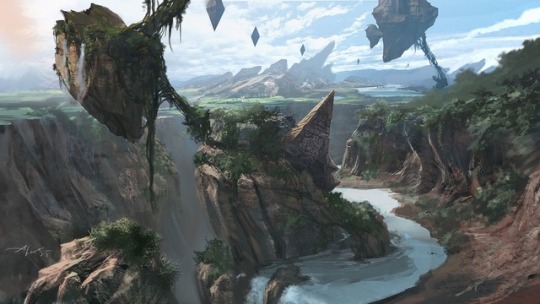
“Zendikar’s terrain is racked with violent and erratic changes. The land itself seems alive, and it’s surface and botanical life often writhe as though in pain, causing tectonic chaos, extreme weather, and sudden destruction. Waves of geological upheaval sometimes wash across the world, leaving nothing unchanged in their wake. All this volatility is collectively referred to as “the Roil.”
The Roil always seemed to be a natural phenomenon, one of the peculiar characteristics of Zendikar that was perhaps tied to its unique mana, the hedrons, or its own fierce ecology. Planeswalkers recognized this volatility as what kept Zendikar dangerous and untamed - free of large cities, sophisticated commerce, and other trappings of well-developed civilization.
The rise of the Eldrazi intensifies the Roil, and it soon becomes clear that the Roil is Zendikar’s own effort to fight off the Eldrazi. The violent upheaval sometimes seems to target the Eldrazi broods, leading some survivors to try to follow the Roil as a means of protection against swarms of Eldrazi, but the Roil’s movements are too unpredictable to follow - and it’s all too easy to get caught in its tempests when it suddenly shifts direction.
The Roil’s effects are violent, enormous, and extreme. They include the following:
Rock Crags. Large boulders and shards of rock erupt from the earth, then subside when the Roil shifts away. These spikes vary in size - from large hills to gigantic peaks. The crags can uproot forests and destroy settlements.
Dust Storms and Tornadoes. Winds generated by the Roil can kick up dust, debris, and vegetation and turn them into a fierce, scouring wave or a devastating funnel cloud.
Tidal Waves. Over large bodies of water, the Roil creates tidal waves that can crash into the high cliffs and flood the forests beyond, or whirlpools that can suck a boat to the bottom of the sea.
Sinkholes. Ground that has been disrupted by the Roil often opens into sinkholes, as large sections of land unexpectedly plummet into the ground.
Gas Geysers. When the earth is displaced, geysers of noxious, sulfurous gas can erupt from underground. Some of these geysers are toxic and can kill nearby life.
Meteoric Growth. Because the Roil is magical in nature, it can affect biology as we as geology and meteorology. Under the influence of the Roil, a tangle of undergrowth can double its size in a day. Occasionally this growth persists; usually it dies down after the effects of the Roil pass.
Tectonic Upheaval. At its strongest, the Roil can dislodge entire plates of earth and create new ridges and peaks. These dramatic upheavals send shock waves through the entire continent and can change miles of landscape in mere minutes.

Occasionally the Roil takes on a literal life of its own. Elementals - animated forces of land and nature - are common enough on Zendikar, but when the Roil itself animates as an elemental, the result is a living vortex that devours everything in the vicinity, even the souls of the living.
Most of Zendikar’s inhabitants have no way to predict the approach of the Roil, though many animals seem to be able to sense its approach earlier than most humanoids. Flocks of birds might fly screeching out of the trees, or herds of oxen might stampede toward shelter. The Roil sends powerful tremors through water, so swimming creatures - including the merfolk - often have more warning of its approach than those confined to land.” - James Wyatt
Art by Raymond Swanland
48 notes
·
View notes
Note
Hey Mark, I had a question about the story of M19. From the Weekly MTG Stream, you guys talked about the Elder Dragons will have a part in the story, but I was wondering which Elder Dragons you guys were talking about, the Elder Dragons from Dominia (Bolas, Palladia-Mors, etc.) or the ones from Tarkir (Atarka, Dromoka, etc.)?
The ones from Legends - the original Elder Dragon Legends.
161 notes
·
View notes
Photo




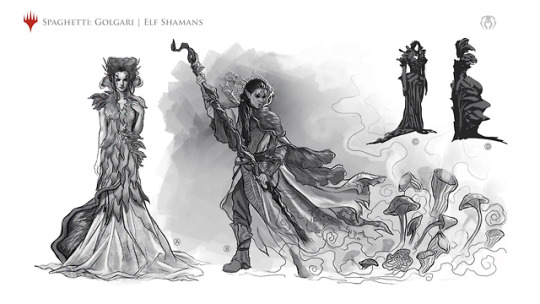
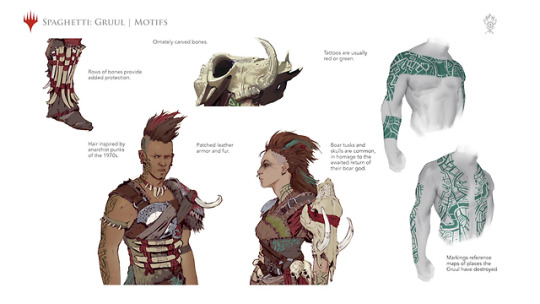
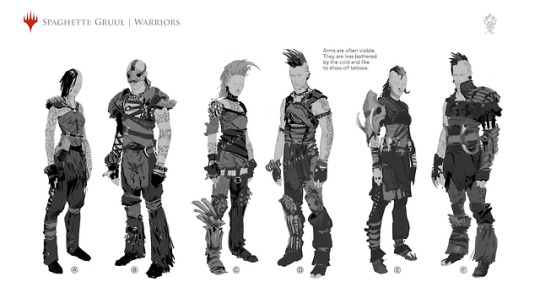



Sick new Ravnica art from today’s Spring 2018 announcement video! A few guilds getting some new motifs!
706 notes
·
View notes
Text
Let’s Talk About Return to Dominaria: Episode 8
Return to Dominaria: Episode 8 does not miss a beat as we pick up where we left off with Chandra and her search for Jaya Ballard.
If you follow my fan theories, let me say that you probably won’t be disappointed.

Pyromancer’s Goggles by James Paick
Afficher davantage
100 notes
·
View notes
Text
Nicol Bolas, Kaladesh, and the Planar Bridge.
As stated on a image shared by WOTC in august 2016, the main goal of Kaladesh Inventor Fair was to incite artificers to do research on, quote; "...alternate means of matter transportarion."
And guest who was the Head Judge at the Inventors' Fair....
Nicol Bolas needed a planar portal for his plots. He send Tezerret to Kaladesh, with the mission of kickstarting the invention of a Planar Bridge. Tezerret arrive and organize the Inventors Fair. Rashmi want to win it and work hard to invent a Planar Gate, which she did.
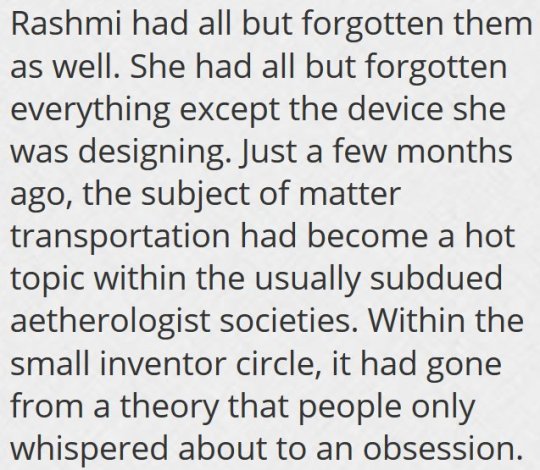
Having his plan work, Tezerret proceed to steal the Planar Gate and go back to Bolas, who use the Gate to steal the Immortal Sun from Ixalan, the plane were planeswalker get trapped on

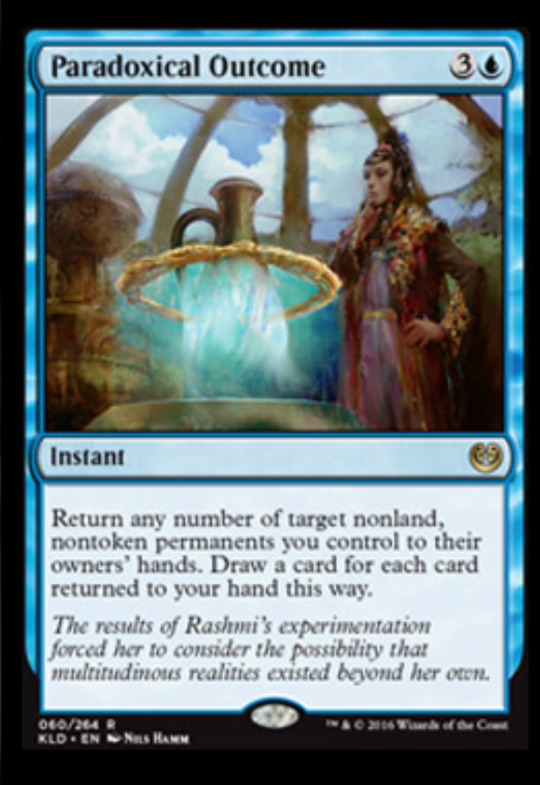



0 notes
Text
This is how Dominaria designer summarize Dominaria set. :
"A world of wizards and castles, and if you dig the ground six feets deep, you hit rusted metal. "
Listen to this podcast, its great
http://media.wizards.com/2018/podcasts/magic/MS_Podcast_20180419_x9JW2v.mp3
0 notes
Photo





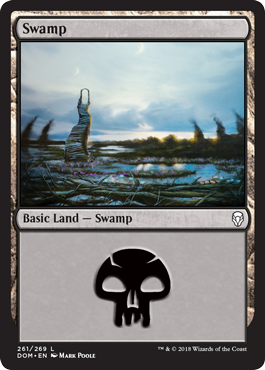




Mark Poole‘s cycle of basic lands in Dominaria each reference the lands he illustrated in Fallen Empires. Archways from each old land reappear on the newbasics, or the tree holes in the case of the Green lands. The original cycle shows areas already in ruin, and while the basics continue that theme, they are also each burgeoning with new life. The empires of Sarpadia fell millennia ago, but maybe there’s still hope that the continent can be recolonized one day.
693 notes
·
View notes
Text
Toplining: Brainstorming visual ideas for Magic card art
HEY DOUG HOW DOES A PIECE OF MAGIC ART GET BORN?
The super-short answer is: someone on the creative team writes an art description, and an artist creates the illustration based on that art description. Boom.
But there are a lot more steps than that. Today I’m going to talk about one of the earliest steps in the process of developing Magic art – a step we call toplining – and then we’re going to try our hand at toplining right here on tumblr.
The art of a Magic card is handcrafted especially for that card. The gameplay mechanics of the card come first, and the art is built around that card to bring it to life. The art becomes a visual expression of that particular game piece in the flavor of the Magic multiverse.
The bridge between the card’s art and its mechanical identity is a flavorful idea that we call the concept. The concept is very closely related to the art description, which is a set of instructions for the artist that gets across the concept in visual language. The act of coming up with concepts for new Magic cards and turning them into art descriptions is a process we call concepting, and the person who writes the concepts is the conceptor.
(Yep, it’s “concept” as a verb. Not “conceptualizing.” Nobody got time for that. “Concepting.”)
An example of a concept might be:
A spell that summons a fountain of lava out of the ground.
And an art desciption based on that idea might be:
SETTING: Ixalan
LOCATION: A clearing in the jungle
ACTION: Show tendrils of lava gushing up out of cracks in the ground, twisting into crazy red-hot spirals. In the background, we see the Sun Empire shaman who’s casting this spell, maybe guiding the spell with artful arm gestures.
FOCUS: The lava tendrils should be the main focus here.
MOOD: A showy spectacle of heat and magic
Officially the “concept” is the idea and the “art description” is the expression of the idea, but we often use those terms interchangeably. (“Are you done writing all the concepts for the winter set?” “Almost, just gotta think up two more art descriptions!” Etc.)
Concepting is an extremely exacting skill. It requires a fertile visual imagination, excellent writing and wordcrafting skills, deep knowledge of the worldbuilding and lore of Magic’s settings, and a thorough understanding of Magic gameplay. It requires thinking about what the card does, what visuals from the world guide might match the mechanics, how big or small the power and toughness are, all the visuals you’ve already used in the set or in previous sets, what kinds of motifs or themes or symbols you want to communicate in the setting, what’s possible to illustrate by an artist, how this card relates (or doesn’t) to the story, whether this thing flies, and more.
Concepting a card is weird and fun and deeply hard. And let me tell you, concepting an entire Magic set is VERY weird and VERY fun and VERY DEEPLY HARD. It’s hard enough to come up with a few ideas for an artist to illustrate – the conceptor must come up with up to 250 of them at a time, multiple times per year.
That’s where toplining comes in. Toplining is the process of brainstorming and recording lots of possible visual concepts for each card. Before the set’s conceptor sits down to start writing all the art descriptions, they meet with a team to come up with a list of potential visual ideas for each card, so that the conceptor will be armed with many ideas once they start writing art descriptions for realsies.
That toplining team is different for every set, but it usually consists of (1) the lead conceptor, the person who’ll write all the art descriptions for the set, who is often also the creative lead for that world; (2) the lead art director for the set, who will be in charge of commissioning out the art when the art descriptions are finalized, and who provides useful feedback about the kinds of visual ideas they want to see in the set and on kinds of ideas that will or won’t work; and (3) the lead set designer for the set, who provides useful information about how the card is likely to be used or what audiences it’s meant for.
That toplining team goes through the set card by card. Everybody calls out ideas or looks up possible visuals in the world guide, and the conceptor records the best ideas for future use. Ultimately it’s the conceptor’s responsibility to write excellent art descriptions for all those cards, so it’s on the conceptor to decide what ideas are exciting useful to them and which are just “ehh.”
When I’m the conceptor, I often ask the team questions to help spur ideas. “Okay, this is a common 2/2 flyer in blue. Does this world have drakes? If it’s a drake, what’s special about this one? Is there a way this critter could be tribally relevant in the set, or is this a weirdo one-off? Would this be better as a flying humanoid of some kind, and if so, how are they flying? What’s the weirdest place we could see it flying through? What kind of mage summons this thing, and for what purpose?”
And so on. I try to roll past the first two or three ideas to get into more uncharted territory, even if the quick answer feels like the right one. The room answers my questions, often with ideas building on each other, letting us draw out the hottest ideas.
Here’s a pretend transcript for toplining a card:
“Okay, this one is… a green ramp spell. What could this be?”
“Hm. Maybe it’s like a wave made out of land?”
“Isn’t that just Rampant Growth?”
“Or… an elf reaches down and touches the ground.”
“Or she’s touching a tree. And the branches light up with magic.”
“*typing* Okay. But this lets you get any basic land. How does it represent getting multiple colors?”
“The branches create lots of different kinds of fruit?”
“Yeah, and each one’s a different color.”
“*typing* Let’s try another direction. What if this were a natural phenomenon, what would it look like?”
“Maybe it’s a rainstorm, that creates new growth.”
“A rainbow!”
“A rainbow, and where it touches the ground, new life sprouts up.”
“*typing* Cool. Anything else?”
“I keep thinking of how spells like this go in decks that want to cast big creatures.”
“Yeah?”
“So maybe like, it’s whatever happens before big monsters show up. The deep rumble in the ground.”
“What’s the visual form of a deep rumble?”
“Those ominous ripples in the water. But in a green way. Ripples in the earth!”
“*typing* Ooh, that’s cool. Okay, I think we’ve got enough for this card. On to the next one.”
And so on, card by card, for the whole batch of cards. Note that the team doesn’t dwell on the full art descriptions during toplining. There’s no discussion of detailed locations, or compositions, “mood lines” – that’s for later. Toplining is about breadth of ideas rather than depth.
Also note that there’s lots of riffing. It’s a dynamic process, about branching from one idea to another, bouncing around till we find a good fit for the card.
The most usable topline ideas are:
(1) Relevant. The idea should be relevant to, or at least should not contradict, the card mechanic or its color. We always want amazing art, but the idea should make sense with the values of the color(s) of mana in its cost and with how the card is played. Help the conceptor find ideas that will actually match the card.
(2) Visual. The idea should be inherently visual, or lead to a visual. The whole point of these ideas is for an artist to eventually illustrate them. An abstract or narrative concept can be cool, but isn’t super helpful unless it can be expressed visually. What’s your idea LOOK like?
(3) Simple. The idea should be able to be expressed simply, with few visual elements. Massive crowd scenes with tons of figures often look muddy at card size. The best bet is a strong single subject for the artist to focus on, so help the conceptor find ideas that can lead to a strong, tight visual.
Okay, let’s try it! We’re gonna do some toplining right now. I’ll give you a bare-bones card mechanic (note: this is not a real card), and you throw out visual concepts for that card in the comments below. For extra fun, riff on others’ ideas, or ask each other probing questions, like we do in actual toplining meetings. Ready?
4R
Sorcery
CARDNAME deals 4 damage to target creature and 1 damage to another target creature.
What’s this spell about? What’s it look like? Who’s casting it, or who’s its victim? Is it an actual spell someone’s casting, or more of a natural phenomenon, or an effect of some creature? What plane is this happening on? Where might be an unusual spot for this to take place? And again what does this effect LOOK like?
I don’t want full art descriptions – just quick toplines! Go!
280 notes
·
View notes
Text
The Skirsdag cult on Innistrad; the worshipper of Emrakul
On this Twitter thread, I explain every clues that point toward the conclusion the Skirsdag cultists turned their devotion toward Emrakul to gain immortality.
https://twitter.com/JasonVorthos/status/975541701791055873?s=20
0 notes
Note
In the ongoing representation efforts by wizards, left handed midget serial killers born in Croatia named Steve seem to have been left out. When is the discrimination going to end?!?!
I get that you’re trying to mock diversity and inclusion, but I think it comes from an ignorance of what it means to feel excluded. When you’ve lived your life in the majority, it’s easy to take it for granted that you see yourself represented in the products and entertainment you use.
But every time we branch out (and I’m not exaggerating, *every* time) and represent a new segment of people, I get heartfelt messages from them about how much it means to them to see themselves in the game.
The reason “Wonder Woman” and “Black Panther” have been such cultural touchstones is because it’s allowing new groups of people to experience something they’ve never experienced before.
I get it’s easy to mock that when it’s something so basic to your experience that you don’t even realize it’s a thing you would miss if you didn’t have it, but I beg for you to try and see life through other people’s perspectives just as I always talk about how good designers see the game through different players’ perspectives.
Try to take actions that build up the world and make it a better place for everyone than tear it down for others to make your world better in comparison.
4K notes
·
View notes
Photo



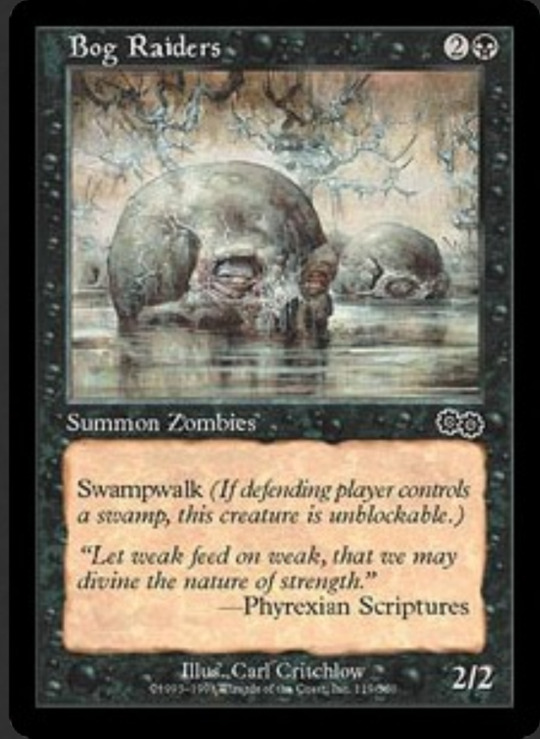
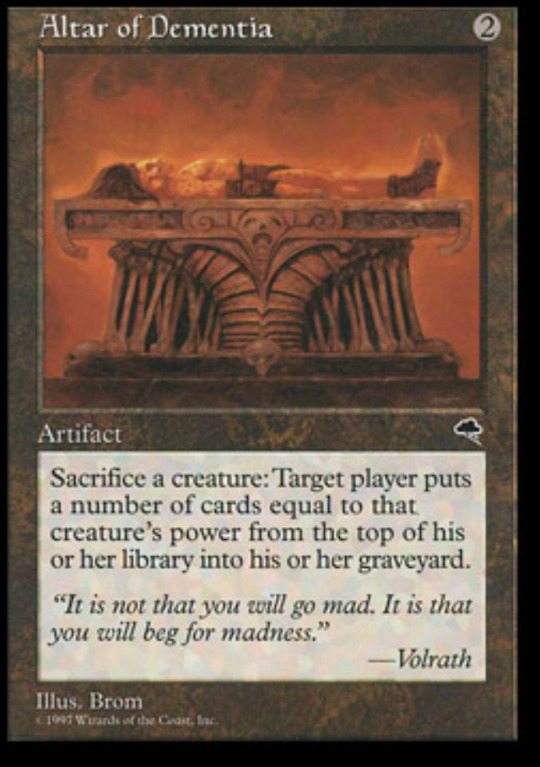
The new card Phyrexian Scriptures appear in the flavor text of multiple cards depicting the old Phyrexia.
1 note
·
View note
Photo

The history and behind the scene of Fallen Empires MTG set.
0 notes
Photo

This is great flavor. On Dominaria, people don't know Liliana Vess turned into a Planewalker when her brother died Her story is a legend about the origin of the Will-o’-the-Wisp in the swamp.
0 notes
Photo

Every religious aspect of the 4 Ixalan tribes are just a by-product of Azor trying to get rid of a failed project. This is the best exemple we had so far of the lifechanging impact Planeswalker have on the insignifiant mortals they visit.
0 notes
